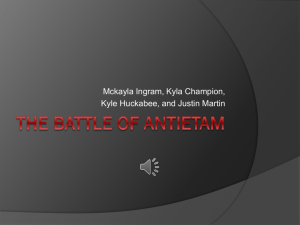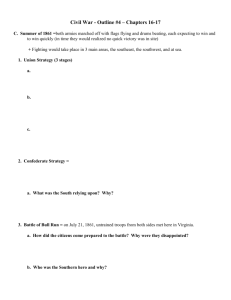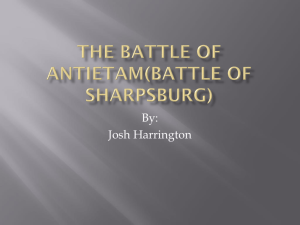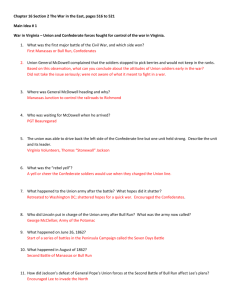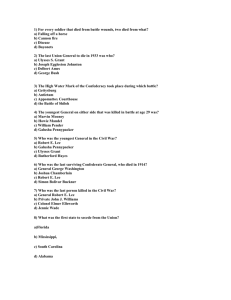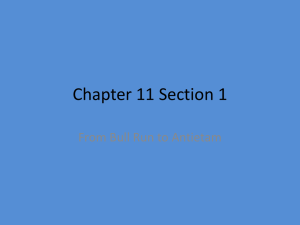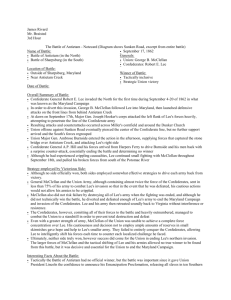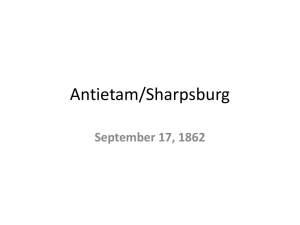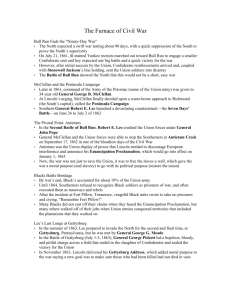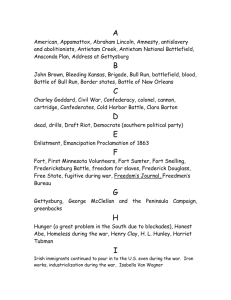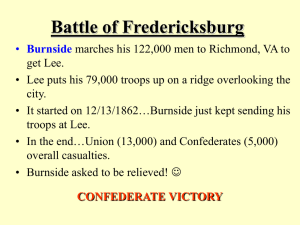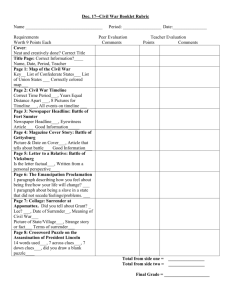Battle at Antietam
advertisement
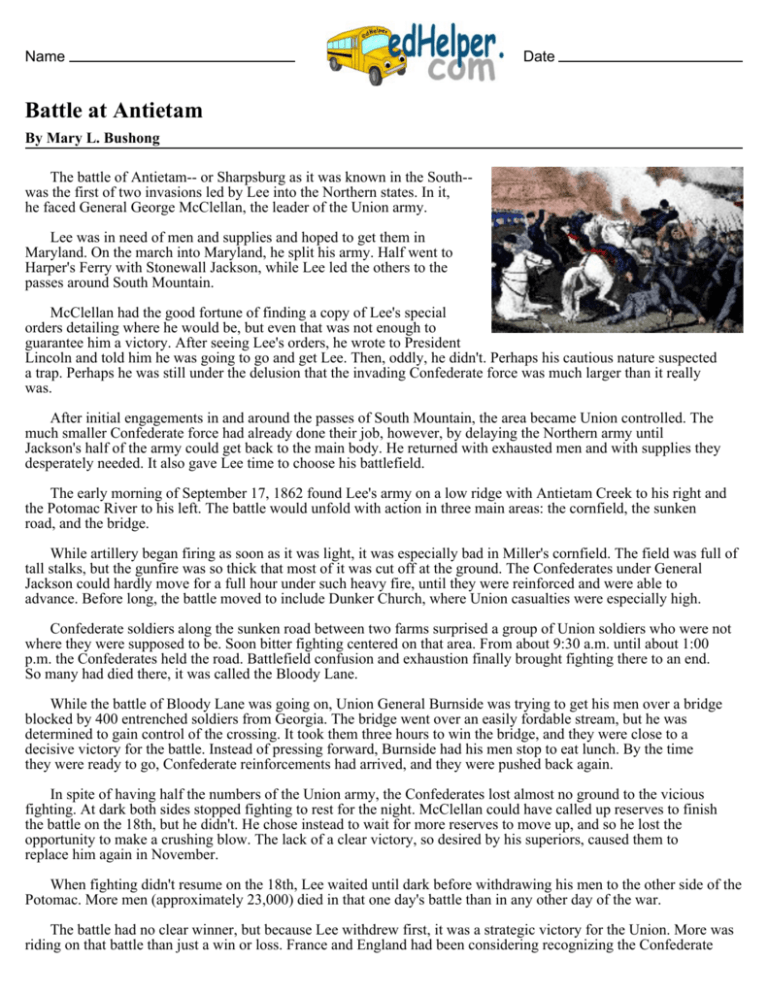
Name Date Battle at Antietam By Mary L. Bushong The battle of Antietam-- or Sharpsburg as it was known in the South-was the first of two invasions led by Lee into the Northern states. In it, he faced General George McClellan, the leader of the Union army. Lee was in need of men and supplies and hoped to get them in Maryland. On the march into Maryland, he split his army. Half went to Harper's Ferry with Stonewall Jackson, while Lee led the others to the passes around South Mountain. McClellan had the good fortune of finding a copy of Lee's special orders detailing where he would be, but even that was not enough to guarantee him a victory. After seeing Lee's orders, he wrote to President Lincoln and told him he was going to go and get Lee. Then, oddly, he didn't. Perhaps his cautious nature suspected a trap. Perhaps he was still under the delusion that the invading Confederate force was much larger than it really was. After initial engagements in and around the passes of South Mountain, the area became Union controlled. The much smaller Confederate force had already done their job, however, by delaying the Northern army until Jackson's half of the army could get back to the main body. He returned with exhausted men and with supplies they desperately needed. It also gave Lee time to choose his battlefield. The early morning of September 17, 1862 found Lee's army on a low ridge with Antietam Creek to his right and the Potomac River to his left. The battle would unfold with action in three main areas: the cornfield, the sunken road, and the bridge. While artillery began firing as soon as it was light, it was especially bad in Miller's cornfield. The field was full of tall stalks, but the gunfire was so thick that most of it was cut off at the ground. The Confederates under General Jackson could hardly move for a full hour under such heavy fire, until they were reinforced and were able to advance. Before long, the battle moved to include Dunker Church, where Union casualties were especially high. Confederate soldiers along the sunken road between two farms surprised a group of Union soldiers who were not where they were supposed to be. Soon bitter fighting centered on that area. From about 9:30 a.m. until about 1:00 p.m. the Confederates held the road. Battlefield confusion and exhaustion finally brought fighting there to an end. So many had died there, it was called the Bloody Lane. While the battle of Bloody Lane was going on, Union General Burnside was trying to get his men over a bridge blocked by 400 entrenched soldiers from Georgia. The bridge went over an easily fordable stream, but he was determined to gain control of the crossing. It took them three hours to win the bridge, and they were close to a decisive victory for the battle. Instead of pressing forward, Burnside had his men stop to eat lunch. By the time they were ready to go, Confederate reinforcements had arrived, and they were pushed back again. In spite of having half the numbers of the Union army, the Confederates lost almost no ground to the vicious fighting. At dark both sides stopped fighting to rest for the night. McClellan could have called up reserves to finish the battle on the 18th, but he didn't. He chose instead to wait for more reserves to move up, and so he lost the opportunity to make a crushing blow. The lack of a clear victory, so desired by his superiors, caused them to replace him again in November. When fighting didn't resume on the 18th, Lee waited until dark before withdrawing his men to the other side of the Potomac. More men (approximately 23,000) died in that one day's battle than in any other day of the war. The battle had no clear winner, but because Lee withdrew first, it was a strategic victory for the Union. More was riding on that battle than just a win or loss. France and England had been considering recognizing the Confederate Name Date government as legitimate. The loss made them choose to wait. The outcome also encouraged President Lincoln to issue the first drafts of the Emancipation Proclamation. Battle at Antietam Questions 1. McClellan found a copy of Lee's special order. A. False B. True 2. When McClellan knew where Lee was going to be, he told the president he was going to get him. Why didn't he? 3. Armies wanted to defend: A. High ground B. Low ground C. A river D. Flat ground 4. Which of these was not part of the battle of Antietam? A. The bridge B. The sunken road C. The cornfield D. The stream 5. The sunken road was called the: A. Blood Soaked Road B. Bloody Lane C. Bloody Road D. Lane of Blood 6. According to its use in the story, what does the word entrenched mean? A. Sitting in a ditch B. To sit firmly C. To trespass D. Wearing a trench coat 7. Why would Burnside stop to eat lunch when his men were so close to helping win the battle? Name Date 8. General McClellan seemed to make several errors in the battle. What were they, and how might they have changed the outcome? General Lee split his army for a short time. One half attacked Harper's Ferry for much needed supplies and then returned, while the other half distracted the Union soldiers. Some people thought Lee might have won the battle if he had kept his army together. If you were in his shoes, what would you have done? When the Confederates had a strategic loss at Antietam, foreign governments like England and France put off recognizing the Southern government as legitimate. How would that have affected the Confederacy in the face of the world?
